[This post is part of an ongoing series – you can access first post here.]
Several years ago we were fortunate enough to have a family from our church host an exchange student from Paris. I have many fond memories from her time with us, but there was one particular episode that I have never been able to forget. During one week in the summer, we attended a Christian camp and, as was the tradition each morning, the entire camp gathered around the flagpole and recited the pledge of the allegiance as the flag was raised. Our friend from France leaned over to me a
nd asked, “Why do you guys worship your flag?”
I’m sure my patriotic, Christian friends would be quick to dispel her confusion and assure her we do not worship the flag, but rather honor it and that for which it stands (isn’t that part of the pledge?) A few years ago, I ran across an essay by David Scotchmer entitled “Symbols Become Us: Toward a Missional Encounter with Our Culture through Symbolic Analysis.”[1] It helped inspire an article I wrote which appeared in the Restoration Quarterly journal back in 2010, and has helped me sift through the meaning and power of symbols. One of the early points that Scotchmer makes is, “One of the failures of the contemporary church is its inability to see its own captivity to the rules and norms of Western society.”[2] He focuses on the consumer-oriented approach many churches were having (and continue to have) in addressing spiritual needs, but his comment is just as revealing when applied to politically-infused debates like the one currently raging regarding the national anthem at sports venues.
As I’ve read articles and witnessed the responses by Christians to this entire discussion it is clear to me that for the vast majority of Christians offering their opinions, they are allowing the socio-political system of the Unites States to frame their response. The responses tend to be binary: the athletes are using their platform to speak out against police brutality and social injustices rooted in racism OR the athletes are speaking out of turn and are providing an unnecessary distraction from actions/discussions that are more likely to provoke healthy dialogue and, hopefully, change. While the binary responses don’t fall definitively down party lines, the vast majority do.
To me, this whole discussion provides the perfect opportunity to talk about the power and place of symbols. Christians in the United States have an easy time pointing out the propagandizing emphasis in nations like China and North Korea, but remain mostly oblivious to the way in which it works in our own country. Go to nearly any toy story in our country and you’ll find plastic versions of fighter jets, tanks, and army men.
A few years ago while we were on spring break, my family went to the National Naval Aviation Museum in Pensacola, FL. I was appalled during our time there to see children playing on old, emptied bomb shells. It was like a playground.
One could wonder if the abundance of red, white, and blue in the US is visible from space. Consider our superheroes and cartoons: Captain America, Superman, and Wonder Woman – all dressed in red, white, and blue; Superman fighting for “truth, justice, and the American way.” Too easily do we dismiss these kinds of symbols as harmless and innocent. Make no mistake, the nation has a vested interest in indoctrinating its citizens to the power of its military and the righteousness of its cause. From a humanistic perspective, we can argue this away as a necessary evil of the nation-state, but as Christians called to a different citizenship – a different kingdom – we must be cautious to fall under their persuasive powers.
This brings us back to the vested interested the United States has in the patriotic hubbub that precedes most professional sporting events. Scotchmer states that “symbols embody the meaning of culture and serve as vehicles and repositories of meaning. Symbols express a worldview and join it to an ethos in ways that make it both meaningful and coherent.”[3] That’s why there is such unrest when someone challenges a nation’s symbols – they are calling into question the worldview and the presupposed meaning and order of the said culture.
Those who argue that the protesters have chosen a poor venue for their protest and/or should devote their time to (what they see as) civil discourse are assigning the symbol of the national anthem and the flag as a matter of core identity (which is often

Image from http://www.eurweb.com
wrapped up in the sport itself – think baseball as the national pastime and football as America’s game – these too function as symbols). Those who kneel or tweet #ikneel desire to bring attention to what they view as the insufficiency of the symbol. For some, the symbol doesn’t mean to them what it means to the other side, and for others, the symbol does mean that, but the manifestation of that symbol is sorely lacking.
Another quote from Scotchmer is helpful here, “Symbols provide powerful models of reality, as well as models for it, by giving meaning – that is, objective, conceptual form – to social and psychological reality both by shaping themselves to it and by shaping that reality to themselves. How people spend their time, money, and energy [in today’s world we might add how they spend their time on social media] reveals dramatically where their loyalties lie and which symbols they choose to preserve and promote.”[4] Which brings me to the point I want to make in this post.
I wrote in the introduction to this series of articles, “As I’ve sifted through comments on social media and listened to countless opinions on talk shows and news

Image from http://www.dreamstime.com
radio, more than the political divide in this country, this whole saga is revealing a great deal about the state of Christianity in the United States.” In my opinion, arguing about kneeling or not kneeling is a distraction from the bigger problem in Christianity in the United States. This has put on display just how infested the US church is with American patriotism. We may give lip service to the church’s presence in the rest of the world, but episodes like this reveal the true scope of the disease.
Contrary to the militaristic symbols of power and might regularly put on display by the US government, the Bible is rife with symbols of its own. The Bible declares that the eternal destiny of the world was brought about by the symbol of a lamb that looked as though it had been slaughtered. Rome is depicted through the Bible with its own symbols of power and might (dragons and beasts), but they are always undone by a meek and mild Savior.
Regardless of your opinion regarding why the kneeling protests are taking place, you should be able to at least acknowledge peaceful kneeling during a nation’s anthem is not an affront against our faith. Perhaps more than anything else, this needs to be said: Honoring a nation’s anthem is not the business of Christians. As aliens and strangers, that’s just not our battle, so those who are quick to argue against those who are protesting should be careful in considering what exactly it is they are calling for. We are often told about those “brave soldiers who have given their life for the stars and stripes and our respect is rooted in them” but as Christians we must be mindful of the thousands around the world who have been murdered by the bombs those brave soldiers dropped. And we must be careful in our justification of the United States as “better than the other nations” – it is a great nation, but it is still not our home! Tony Campolo famously said, “The United States may be the greatest Babylon in the history of the world – but it’s still Babylon!” The kingdom of God is bigger than this nation or any other, and so for us to align ourselves in support of any nation’s anthem puts us on pretty shaky ground theologically.
We are allowing ourselves to get sucked in and divided by arguments and discussions that just aren’t kingdom matters. Justice is – and if someone kneels for that reason, we should be pretty slow to cast judgment as Christians. If anything, the act of kneeling or protesting during a nation’s anthem could be one of the most Christian things a disciple can do! Truth be told, we need more of that, than less. At the same time, wouldn’t it be nice to see some of the same fervor wrought by this issue applied to how communion is observed, the sacred assembly, and the reading of Scripture. Christians should be much more concerned with flippant attitudes during moments like these than getting wrapped up in defending the traditions of the national anthem at a sporting event.
I ended my article in Restoration Quarterly with the following anecdote from Robert Coles’ book: The Political Life of Children, and it seems to be a fitting way to conclude this article. He describes a twelve-year-old Hopi Indian boy who wrestled with his identity living amid a nation that was not his own.
The Indian boy will learn to bow to America’s power, even as his grandfather did: Horses are not Sky Hawks and Phantoms . . . [He] will only smile and shrug his shoulders when asked about presidents, congressmen, governors; they exist, he knows, but they belong to others, not him, though he has not the slightest doubt that the decisions those leaders make will affect him . . . They are they, we are we; their leaders are theirs, ours are ours; yet, of course, we are all part of some larger scheme of things – America.[5]
It’s about time for Christians in the United States to act like they are part of some larger scheme of things – the kingdom of God.
The next post will look at the challenging realities of living in the midst of a challenging and fallen world, particularly in matters like these.
[1] David Scotchmer, “Symbols Become Us: Toward a Missional Encounter with Our Culture through Symbolic Analysis,” in The Church Between Gospel and Culture, 158-172, edited by George R. Hunsberger and Craig Van Gelder (Grand Rapids, MI: Eerdmans, 1996.
[5] Robert Coles, The Political Life of Children (Boston: Houghton Mifflin, 1986), 47-48.


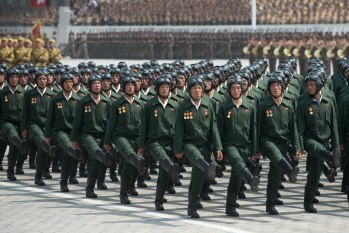 impressive. You can’t help but be impressed by the thousands of soldiers lined up in perfect formations and surrounded by the heavy militaristic symbols of flags, tanks, and warplanes. The United States has its own pomp and circumstance surrounding Presidential Inaugurations and Fourth of July celebrations, but even they tend to lack the military luster of the North Korean parades. There is, however, one venue in American society that does rival the militaristic and patriotic hype of these other counties – sports.
impressive. You can’t help but be impressed by the thousands of soldiers lined up in perfect formations and surrounded by the heavy militaristic symbols of flags, tanks, and warplanes. The United States has its own pomp and circumstance surrounding Presidential Inaugurations and Fourth of July celebrations, but even they tend to lack the military luster of the North Korean parades. There is, however, one venue in American society that does rival the militaristic and patriotic hype of these other counties – sports. My family has attended every Cleveland Indians Opening Day game for over a decade. Patriotism tends to be on steroids for these games. There’s always a flag so large it nearly covers the entire field, red, white, and blue balloons are released, fireworks are shot off, and the military provides a deafening flyover by their war machines. The climax of the pregame pomp is when a local celebrity comes out to sing the national anthem. For those of us who have grown
My family has attended every Cleveland Indians Opening Day game for over a decade. Patriotism tends to be on steroids for these games. There’s always a flag so large it nearly covers the entire field, red, white, and blue balloons are released, fireworks are shot off, and the military provides a deafening flyover by their war machines. The climax of the pregame pomp is when a local celebrity comes out to sing the national anthem. For those of us who have grown 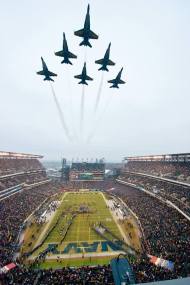 up in the United States over the last 50 years, this is our reality in sports. It is difficult for us to know where patriotism ends and sports begins. The poster child for the prominent connection between “The Star Spangled Banner” and sports is Whitney Houston’s rendition from the Super Bowl in 1991 (her version of the anthem has been a Top 20 hit twice – after that Super Bowl and again after September 11, 2001). It may be difficult for us to imagine a sporting event without the anthem, but how many people know the actual origin of the practice?
up in the United States over the last 50 years, this is our reality in sports. It is difficult for us to know where patriotism ends and sports begins. The poster child for the prominent connection between “The Star Spangled Banner” and sports is Whitney Houston’s rendition from the Super Bowl in 1991 (her version of the anthem has been a Top 20 hit twice – after that Super Bowl and again after September 11, 2001). It may be difficult for us to imagine a sporting event without the anthem, but how many people know the actual origin of the practice?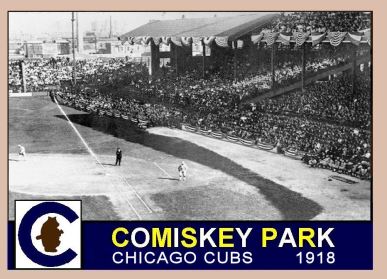
 Tommie Smith and John Carlos provided what, historically, has been the most prominent racially-motivated protest during the anthem when they raised their closed, gloved fist during a medals ceremony in the 1968 Olympic Games in Mexico. Smith and Carlos provided a most dramatic image of protest (they were, by the way, subsequently kicked off the team and sent back to the United States), but there have been many others as highlighted in an
Tommie Smith and John Carlos provided what, historically, has been the most prominent racially-motivated protest during the anthem when they raised their closed, gloved fist during a medals ceremony in the 1968 Olympic Games in Mexico. Smith and Carlos provided a most dramatic image of protest (they were, by the way, subsequently kicked off the team and sent back to the United States), but there have been many others as highlighted in an 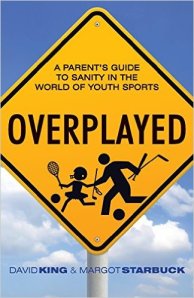


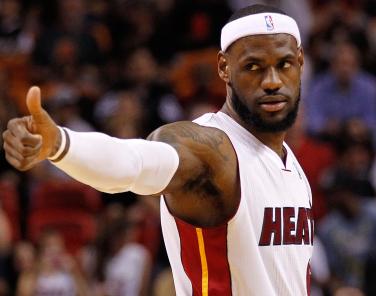





 other team – or player – “down.” Taking them down is part of the game! If we can’t all win – someone has to lose. And we’d just all assume it would be “them ” lose instead of us. And, ever so subtlety, we feel ourselves hoping, not just that we win, but that they lose. Just watch a parent when their child is playing a team with a player who is significantly better than all the other players. They can easily find themselves rooting for that player’s failure as much as their own child’s success. It’s the same feeling we get when we are playing a game when we know that it is impossible to win. Those are difficult emotions to process.
other team – or player – “down.” Taking them down is part of the game! If we can’t all win – someone has to lose. And we’d just all assume it would be “them ” lose instead of us. And, ever so subtlety, we feel ourselves hoping, not just that we win, but that they lose. Just watch a parent when their child is playing a team with a player who is significantly better than all the other players. They can easily find themselves rooting for that player’s failure as much as their own child’s success. It’s the same feeling we get when we are playing a game when we know that it is impossible to win. Those are difficult emotions to process. It was January 11, 1987. I was seven and a half years old. It was Cleveland, Ohio. And it was the first time that Denver Broncos quarterback John Elway slowly and painfully ripped out the hearts of Cleveland Browns fans everywhere. It became known as “The Drive. ” [All Browns fans close your eyes, others can watch this
It was January 11, 1987. I was seven and a half years old. It was Cleveland, Ohio. And it was the first time that Denver Broncos quarterback John Elway slowly and painfully ripped out the hearts of Cleveland Browns fans everywhere. It became known as “The Drive. ” [All Browns fans close your eyes, others can watch this 
 The culmination of the 2006 football season found Meyer’s Gators taking on the Ohio State Buckeyes. I remember watching and listening to Urban Meyer in the weeks leading up to the game. I remember thinking how much of a pompous ass he was. I remember how much I didn’t care for his demeanor and his cut-throat mentality (he has a reputation for running up the score on lesser opponents). Compared to the buttoned-up, senatorial, humble ethos of Ohio State’s coach Jim Tressel, Urban Meyer was an arrogant prick. And that arrogant prick helped kick my team’s behind in one of the more lopsided national championships you will ever see. Which made me hate him all the more.
The culmination of the 2006 football season found Meyer’s Gators taking on the Ohio State Buckeyes. I remember watching and listening to Urban Meyer in the weeks leading up to the game. I remember thinking how much of a pompous ass he was. I remember how much I didn’t care for his demeanor and his cut-throat mentality (he has a reputation for running up the score on lesser opponents). Compared to the buttoned-up, senatorial, humble ethos of Ohio State’s coach Jim Tressel, Urban Meyer was an arrogant prick. And that arrogant prick helped kick my team’s behind in one of the more lopsided national championships you will ever see. Which made me hate him all the more. Now . . . you know what? . . . he wasn’t too bad of a guy after all. Still intense. Still kind of cocky. But don’t you want that for your coach? Then the magical season that was 2014, and the Buckeyes won the first ever college football playoff, and the entire state of Ohio has forgotten all about Jim Tressel. Well, not forgotten, more like forgiven.
Now . . . you know what? . . . he wasn’t too bad of a guy after all. Still intense. Still kind of cocky. But don’t you want that for your coach? Then the magical season that was 2014, and the Buckeyes won the first ever college football playoff, and the entire state of Ohio has forgotten all about Jim Tressel. Well, not forgotten, more like forgiven. However, this reality isn’t limited to the highest levels of sports. It was early on in my son’s baseball career when I realized how conflicted I would be when it comes to his success. If the bases are loaded and there are two outs and the game is tied and my son is up to bat, what is the right outcome to hope for? Do I hope he throws a ball and my son draws the winning RBI? Do I pray for a meat ball right down the middle that I know my son can smash? How do I root him on, without wishing ill on the other team or player? Could it be that the other team needs a win more than our team at the grandest scheme of life? Could it be that the kid in that illustration would be much more greatly blessed with a strike out than my son would be with a walk off hit?
However, this reality isn’t limited to the highest levels of sports. It was early on in my son’s baseball career when I realized how conflicted I would be when it comes to his success. If the bases are loaded and there are two outs and the game is tied and my son is up to bat, what is the right outcome to hope for? Do I hope he throws a ball and my son draws the winning RBI? Do I pray for a meat ball right down the middle that I know my son can smash? How do I root him on, without wishing ill on the other team or player? Could it be that the other team needs a win more than our team at the grandest scheme of life? Could it be that the kid in that illustration would be much more greatly blessed with a strike out than my son would be with a walk off hit?

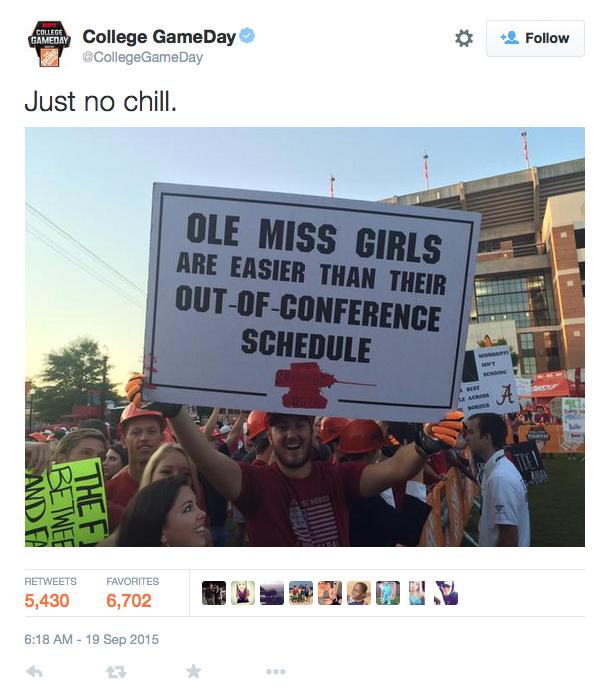
 ESPN took flack for the first sign before GameDay was even over, and Urban
ESPN took flack for the first sign before GameDay was even over, and Urban 

